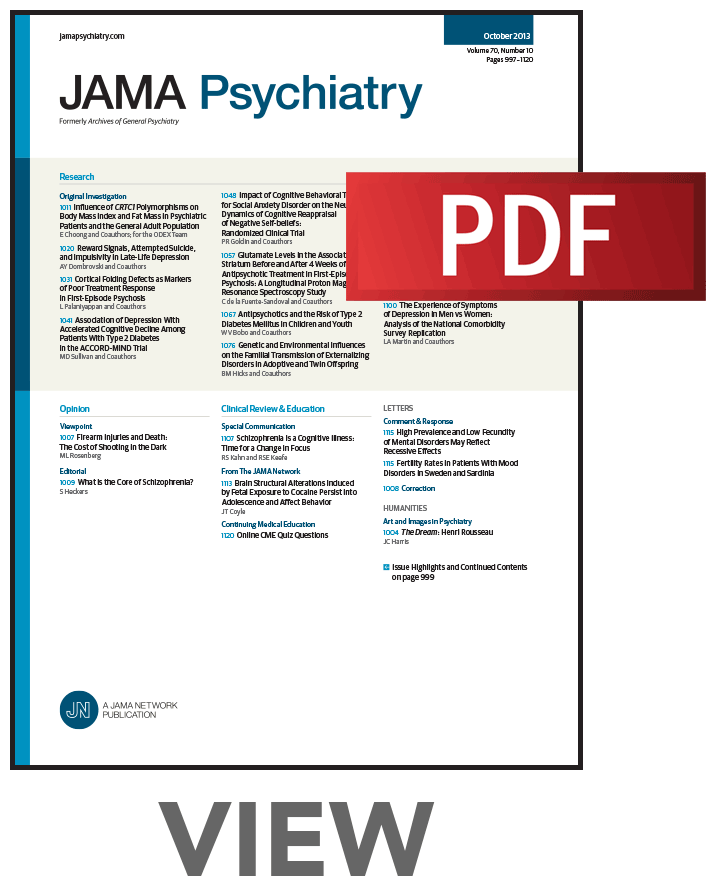Racial Differences in Suicide and Undetermined Deaths in Maryland.
IF 17.1
1区 医学
Q1 PSYCHIATRY
引用次数: 0
Abstract
Importance Undetermined manner of death may obscure the true prevalence of suicide, particularly among Black decedents, and contribute to inequities in health care and autopsy reviews. Objective To identify and compare health care utilization patterns and classification of death by suicide or undetermined manner of death among Black and White decedents. Design, Setting, and Participants This retrospective cohort study used data from the Maryland Suicide Data Warehouse (2012-2020), linking Office of the Chief Medical Examiner records with Maryland Health Care Commission claims. The study included Black and White decedents classified by the Office of the Chief Medical Examiner as suicide or undetermined deaths. The analysis focused on Black and White decedents to align with the study's aim of examining disparities between these groups, and they were the only groups with sufficient sample sizes for meaningful comparison. Data were analyzed from January 2024 to March 2024. Main Outcomes and Measures Primary outcomes were manner of death classification and health care use-outpatient, psychiatry, and emergency department visits-in the 12, 6, and 1 month before death. Racial differences by death classification were assessed with χ2 tests. Results Among 15 832 Black and White decedents (4798 Black individuals [30.3%] and 11 034 White individuals [69.7%]; 11 572 [73.1%] male; mean [SD] age, 44 [15.1] years), Black decedents' deaths were disproportionately classified as undetermined rather than suicide (3984 [83.0%]) compared with White decedents (7160 [64.8%]) despite similar patient characteristics. Firearms were the most common method of suicide, while overdose or poisoning predominated among undetermined deaths. White decedents compared with Black decedents were more likely to access outpatient care before death (suicide: 595 [49.5%] compared with 105 [41.5%]; χ2 = 5.0; P = .02; undetermined: 504 [20.8%] compared with 193 [14.9%]; χ2 = 18.9; P < .001). Additionally, more White decedents than Black decedents had psychiatry visits before death: 400 (33.3%) compared with 61 (24.1%) at 12 months (χ2 = 7.7; P = .006), 283 (23.5%) compared with 39 (15.4%) at 6 months (χ2 = 7.5; P = .006), and 187 (15.5%) compared with 23 (9.1%) at 1 month (χ2 = 6.5; P = .01). Emergency department visits were also higher among White decedents compared with Black decedents before death: 94 (7.8%) compared with 10 (4.0%) at 12 months (χ2 = 4.1; P = .04) and 73 (6.1%) compared with 6 (2.4%) at 6 months (χ2 = 4.9; P = .03). However, emergency department visit rates for decedents with undetermined deaths were similar across groups. Conclusions and Relevance These findings suggest possible undercounting of suicides and misclassification of undetermined deaths among Black decedents. Addressing these disparities is vital for accurate surveillance and targeted suicide prevention efforts.马里兰州自杀和未确定死亡的种族差异。
未确定的死亡方式可能会掩盖自杀的真实流行,特别是在黑人死者中,并导致医疗保健和尸检审查的不公平。目的确定并比较黑人和白人的医疗保健利用模式和自杀或死因不明的死亡分类。设计、环境和参与者本回顾性队列研究使用了马里兰州自杀数据仓库(2012-2020)的数据,将首席法医办公室的记录与马里兰州卫生保健委员会的索赔联系起来。这项研究包括了被首席法医办公室归类为自杀或未确定死亡的黑人和白人死者。分析的重点是黑人和白人的后代,以配合研究目的,检查这两个群体之间的差异,他们是唯一有足够样本量进行有意义比较的群体。数据分析时间为2024年1月至2024年3月。主要结局和测量主要结局为死亡前12个月、6个月和1个月的死亡分类方式和医疗保健使用情况(门诊、精神科和急诊科)。死亡分类的种族差异采用χ2检验。结果15例 832例黑人和白人死者中,黑人4798例(30.3%),白人11034例(69.7%);11 572[73.1%]男;平均[SD]年龄44[15.1]岁),尽管患者特征相似,但黑人死者的死亡被不成比例地归类为未确定死亡而非自杀(3984例[83.0%]),而白人死者(7160例[64.8%])。枪支是最常见的自杀方式,而过量或中毒在死因不明的人中占主导地位。与黑人死者相比,白人死者更有可能在死前获得门诊服务(自杀:595人[49.5%]比105人[41.5%];χ2 = 5.0;p = .02;待定:504人[20.8%],193人[14.9%];χ2 = 18.9;p < 0.001)。此外,白人死者比黑人死者在死前有更多的精神病学访问:400人(33.3%)比12个月时的61人(24.1%)(χ2 = 7.7;P = 0.006), 6个月时283例(23.5%)比39例(15.4%)(χ2 = 7.5;P = 0.006), 1个月时187例(15.5%)与23例(9.1%)比较(χ2 = 6.5;p = 0.01)。白人患者死前急诊就诊次数也高于黑人患者:12个月时,白人患者为94例(7.8%),黑人患者为10例(4.0%)(χ2 = 4.1;P = 0.04)和73例(6.1%),6个月时为6例(2.4%)(χ2 = 4.9;p = .03)。然而,在各组中,未确定死亡的死者的急诊就诊率相似。结论和相关性这些发现提示可能低估了黑人死者的自杀和未确定死亡的错误分类。解决这些差异对于准确监测和有针对性的自杀预防工作至关重要。
本文章由计算机程序翻译,如有差异,请以英文原文为准。
求助全文
约1分钟内获得全文
求助全文
来源期刊

JAMA Psychiatry
PSYCHIATRY-
CiteScore
30.60
自引率
1.90%
发文量
233
期刊介绍:
JAMA Psychiatry is a global, peer-reviewed journal catering to clinicians, scholars, and research scientists in psychiatry, mental health, behavioral science, and related fields. The Archives of Neurology & Psychiatry originated in 1919, splitting into two journals in 1959: Archives of Neurology and Archives of General Psychiatry. In 2013, these evolved into JAMA Neurology and JAMA Psychiatry, respectively. JAMA Psychiatry is affiliated with the JAMA Network, a group of peer-reviewed medical and specialty publications.
 求助内容:
求助内容: 应助结果提醒方式:
应助结果提醒方式:


